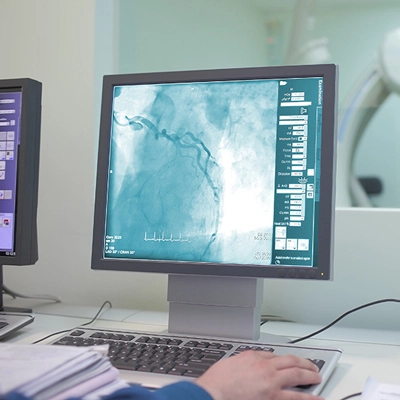
Make Way for Optimal Health Through Angiography & Angioplasty.
All About Angiography and Angioplasty
Angiography and angioplasty are interventional procedures used to diagnose and treat heart conditions. Angiography involves injecting contrast dye into blood vessels to visualize blockages or abnormalities. In contrast, angioplasty is a minimally invasive technique that uses a balloon or stent to widen narrowed or blocked arteries, improving blood flow. Both procedures are crucial in managing cardiovascular diseases.
Angiography Vs. Angioplasty - An Outright Explanation
Angiography and angioplasty are two different procedures used to diagnose and treat blockages or narrowing in the blood vessels. Angiography is a diagnostic procedure that uses X-rays and contrast dye to examine the blood vessels. At the same time, angioplasty is a minimally invasive procedure used to treat the blockages.
Angiography
During angiography, a catheter is inserted into an artery through the groin or arm and guided through the blood vessels to the examined area. Contrast dye gets injected through the catheter, and X-ray images are taken as the dye flows through the blood vessels. The procedure helps doctors to identify any blockages or abnormalities in the blood vessels.
Angioplasty
On the other hand, angioplasty involves using a catheter to guide a balloon in the blockage section, where it is inflated to widen the artery. A stent may be placed to keep the artery open. The procedure is usually performed after angiography has identified the blockage or narrowing.
While angiography is a diagnostic procedure, angioplasty is a therapeutic one. Angiography helps doctors to identify the location and severity of the blockage, while angioplasty helps to treat it. Both procedures are typically performed together as part of the diagnostic and treatment process for blockages or narrowing in the blood vessels.
Treatment Process of Angiography and Angioplasty
The treatment process for angioplasty and angiography typically involves the following steps:
1. Preparation:
Patients will be given instructions on preparing for the procedure, such as not eating or drinking anything for a certain period before the procedure. They may also need to stop taking certain medications prior to the procedure.
2. Anesthesia:
Local anesthesia numbs the area of catheter insertion. Patients are also given a sedative to help them relax during the procedure.
3. Insertion of catheter:
A thin, flexible tube called a catheter is inserted in the groin or arm and guided through the blood vessels to the examined or treated area.
4. Angiography:
If angiography is being performed, contrast dye gets injected through the catheter, and X-ray images are taken once dye flows through the blood vessels.
5. Angioplasty:
If angioplasty is performed, a balloon attached to the catheter is inflated to widen the narrowed artery, and a stent may be placed to keep the artery open.
6. Recovery:
After the procedure, patients are usually monitored for a few hours before being discharged. They will be given instructions on caring for the insertion site and any needed medications.
The process usually takes one to two hours, and patients can generally go home the same day.
Frequently Asked Questions
What is angiography?
Angiography is a diagnostic procedure that uses X-rays and a contrast dye to examine the blood vessels of the body, including the heart, brain, kidneys, and legs.
What is angioplasty?
Angioplasty is a minimally invasive procedure used to treat blockages or narrowing in the blood vessels, typically in the heart’s coronary arteries.
What are coronary angioplasty and stent placement?
Coronary angioplasty and stent placement is a common type of angioplasty used to treat coronary artery disease, which is the narrowing of the blood vessels that supply blood to the heart.
What is balloon angioplasty and stent placement?
Balloon angioplasty and stent placement is another type of angioplasty used to treat blockages in other blood vessels throughout the body.
Is Angioplasty safe?
Angioplasty is a safe procedures, but some risks are associated with it, such as bleeding, infection, and allergic reactions.
How long does the procedure take?
The procedure usually takes one to two hours, and patients can generally go home the same day.
Is there any recovery time associated with the procedures?
Both procedures have shorter recovery times than traditional surgery, but patients may still need to rest and avoid strenuous activity for a few days afterward.
How effective are angiography and angioplasty?
Angiography is highly effective in diagnosing blockages or narrowing in the blood vessels, allowing for appropriate treatment. Angioplasty is also highly effective in treating blockages or limiting the blood vessels, particularly in the heart’s coronary arteries.
What are the risks associated with angioplasty and angiography?
The risks associated with angioplasty and angiography include bleeding or infection or allergic reactions to the contrast dye, damage to blood vessels or organs, and blood clots.
How long do the effects of angioplasty last?
The effects of angioplasty can last for many years, but patients need to adopt a healthy lifestyle, take prescribed medications, and attend followup appointments with their doctor to ensure the best outcomes.
Who is a candidate for angiography and angioplasty?
People with coronary artery disease symptoms or other blockages in the blood vessels may be candidates for angiography and angioplasty. However, the decision to undergo these procedures is based on various factors, including the severity of the blockages, the patient’s overall health, and any other medical conditions.
How can I prepare for an angiography or angioplasty procedure?
Patients should follow their doctor’s instructions on preparing for the procedure, which may include fasting for a certain time, stopping certain medications, and arranging transportation to the hospital or clinic. It is also essential to inform the doctor of allergies or other medical conditions.
Subscribe to Platinum For Heart Newsletter
Sign up now and get free access to our monthly newsletter on Heart health & More
Sources:
1. https://www.apollohospitals.com/heart/angiography-angioplasty
2. https://www.medanta.org/patient-care/programme/heart-vascular-institute/angiography-angioplasty
3. https://www.fortishealthcare.com/india/key-medical-procedures/angioplasty-26
4. https://www.maxhealthcare.in/our-specialities/heart-vascular-care/angiography-angioplasty
5. https://www.narayanahealth.org/specialities/cardiology/angiography-angioplasty
Disclaimer: The information presented by Boston Scientific Corporation is for educational purposes only and does not recommend self-management of health issues. The information should not be treated as comprehensive and does not intend to provide diagnosis, treatment or any medical advice. Individual results may vary and hence, it is advisable to consult your doctor regarding any medical or health related diagnosis or treatment options.
IC-1625803AA-0623

